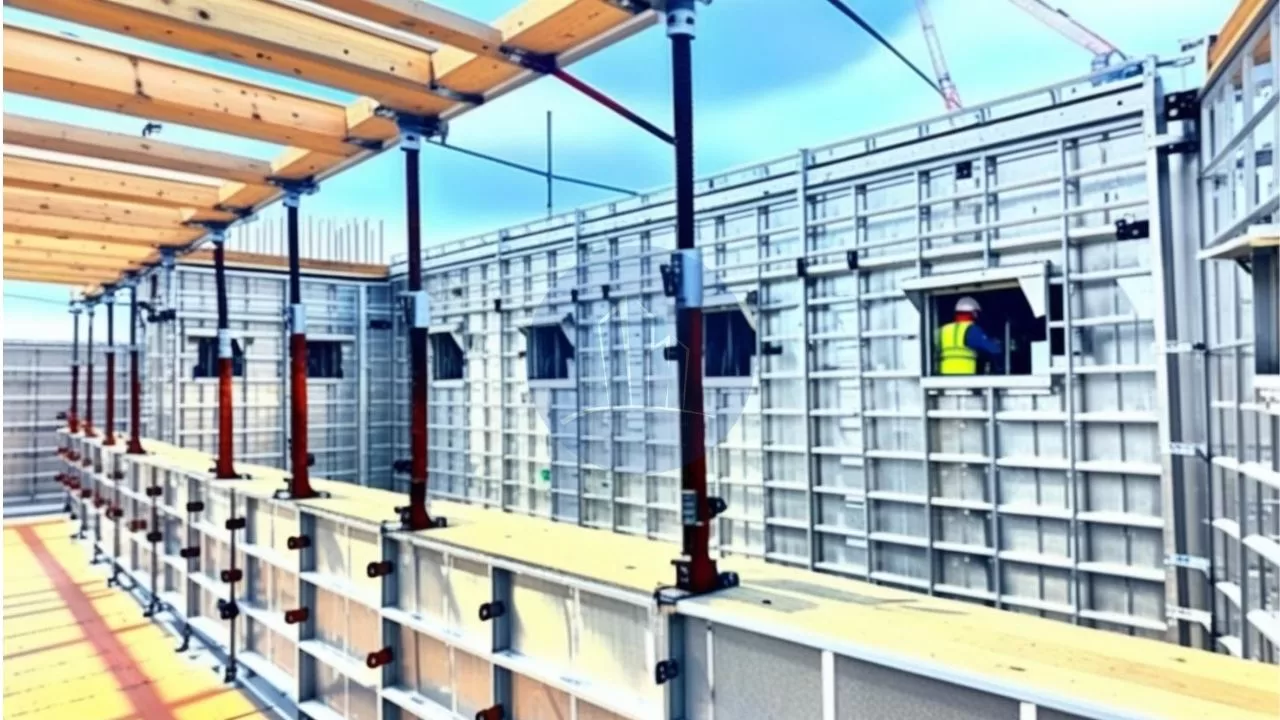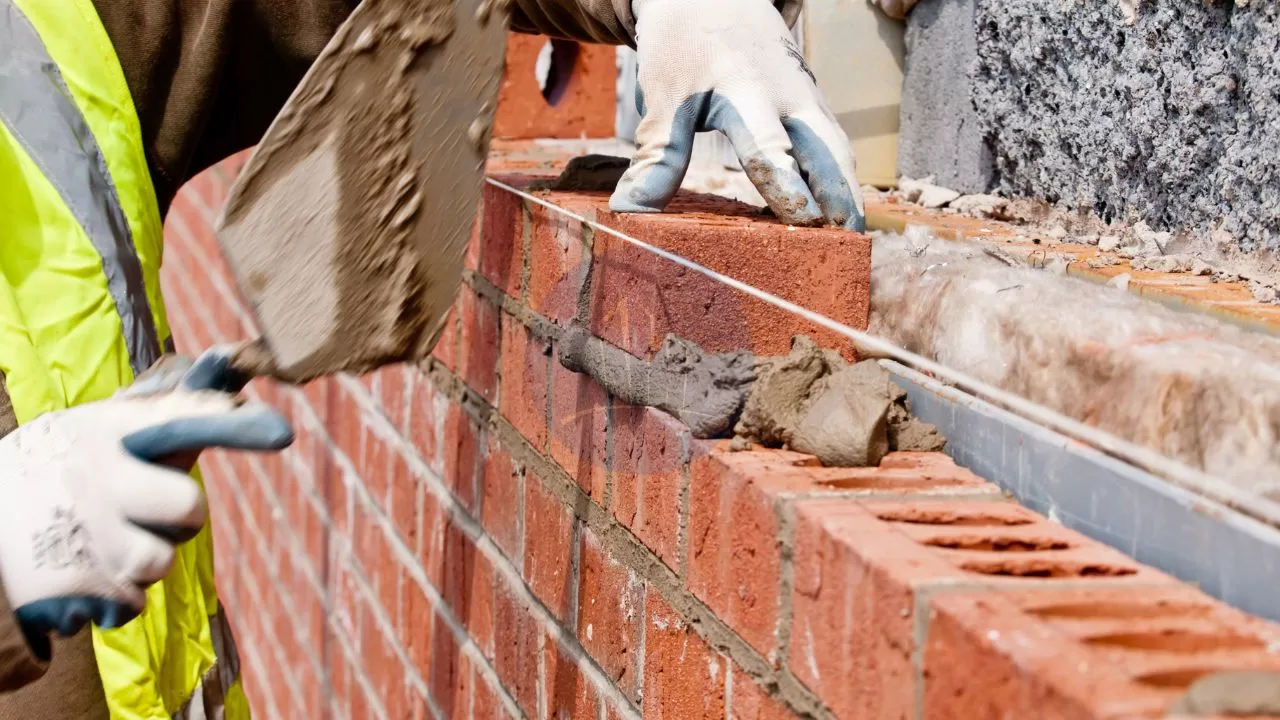Formwork in construction refers to a mould used to shape concrete into structural shapes (beams, columns, slabs, shells) for buildings and other structures. Concrete is one of the most popular building materials due to its exceptional properties and advantages. However, in order to create construction components, concrete must be poured into a specific mould. In order to achieve the desired shape precisely, concrete is occasionally poured into formwork, a type of temporary mould. Formwork types in construction can also be categorised based on the type of structural member they are used in, such as slab formwork for use in slabs, beam formwork for use in beams and columns, and so forth. The formwork and any accompanying falsework must be sturdy enough to support the weight of the wet concrete without experiencing significant distortion.
Timber formwork is the most prevalent type of formwork used for minor buildings. This article explores the various forms of formwork used in construction as well as their characteristics.
Table of contents
Significance of formwork in construction
Formwork is frequently used in a range of shapes and sizes in building, roads, bridges, tunnels, corridor linings, hydroelectric power dams, agriculture headwork, sewage pipeline works, and other applications based on our design materials in the form of PCC and RCC. Falsework is the term for the structures that are needed for formwork in order to prevent movement during construction procedures. Formwork in construction requires a qualified crew and appropriate supervision to ensure high quality. Poor accuracy and expertise during the creation of the formwork lead to subpar work, which wastes time and money.
25 to 30 per cent of the total price of concrete construction is made up of the cost of the formwork. For bridges, this cost proportion could be higher. However, depending on the complexity of the structure, this may exceed 60%.
Quality of good formwork in construction
Although there are numerous formwork materials, the following are general performance characteristics to satisfy the objectives of concrete construction is as follows.
- Easy removal
- Economy
- Rigidity and strength
- Less leakage
- Supports
Easy removal
The design of the formwork should be such that it may be quickly removed with minimal pounding, resulting in less damage to the concrete.
Economy
Formwork serves no purpose in ensuring the stability of completed concrete. So, keeping safety in mind, its cost might be reduced. The formwork should be constructed with reasonably priced, lightweight, readily available materials that are both recyclable and reusable.
Rigidity and strength
Good formwork should be capable to withstand any form of live or dead load. Formwork must be properly aligned to the target line, and levels must have a plane and solid surface. When exposed to weather, the formwork’s material shouldn’t swell or warp. When choosing the formwork, take into account the temperature of the pour as well as the type of concrete being used because both affect the pressure that is applied. Furthermore, the formwork must be sturdy enough to bear the weight of both wet and dry concrete.
Less Leakage
Joints must not leak at any point.
Supports
Formwork needs falsework, which consists of stabilisers and poles, in order to stop moving while construction is being done. Formwork needs to be supported by sturdy, rigid, and rigid supports.
De-shuttering Period as per IS 456 – 2000 for formwork in construction
Let us have a look into the de-shuttering period of various structural components as per IS 456-2000
| Sr. No. | Type of Formwork | Minimum Period Before Striking Formwork |
|---|---|---|
| 1. | Vertical formwork to columns, walls, beams | 16-24 hours |
| 2. | Slab ( props left under ) | 3 days |
| 3. | Beam soffits ( props left under ) | 7 days |
| 4. | Props for Slab | |
| (a). | Spanning up to 4.5m | 7days |
| (b). | Spanning over 4.5m | 14days |
| 5. | Props to Beam and Arches | |
| (a). | Spanning up to 6m | 14days |
| (b). | Spanning over 6m | 21days |
De-shuttering period as per IS 456
Advantages of formwork in construction
Formwork is unquestionably necessary for all construction projects; its fundamental benefit is that no other technique can take its place.
- Concrete structures can be swiftly and affordably built by using formwork.
- A formwork provides suitable access and working platforms throughout the whole construction process, thereby, enhancing worker scaffold safety.
- Formwork helps to reduce project timelines and costs by shortening the floor-to-floor building cycle time, which implies that more projects can meet their budgetary requirements. This, in turn, enables construction managers to provide precise on-time shuttering and de-shuttering of formwork resources, which improves project effectiveness and resource utilisation.
- Formwork assists in creating a smooth concrete finish surface.
Types of formwork in construction
The following are the major types of formworks commonly used in construction.
Timber formwork in construction
One of the first types of formwork utilised in the construction industry was timber formwork. Basically, timber formwork is the most versatile form, is built on-site, and has numerous advantages. In comparison to metallic formwork, they are incredibly lightweight and easy to install and remove. Timber formwork is versatile and can be built to any shape, size, or height. However, for minor projects where the use of local wood is permitted, these kinds of formworks are cost-effective. Prior to usage, the lumber must, however, undergo a thorough inspection to make sure it is termite-free. Timber formwork also has two disadvantages that should be considered: it has a short lifespan and takes a long time on large projects. They are frequently recommended when labour costs are low or when flexible formwork is required for complex concrete components.
The timber formwork should be well-seasoned, small in size, easy to nail without breaking, and free of slack knots. During shuttering, every face of timber that will make contact with the exposed concrete work must be even and smooth.
Plywood formwork
Generally, for plywood shuttering, sheets of waterproof, boiling-level plywood that are suited for shuttering are commonly used. These plywood sheets are attached to wooden frames to form the desired-size panels. Typically, plywood formwork is used in the sheathing, decking, and form-lining applications. Hence, Plywood formwork is the modern-day alternative to wooden formwork in construction. To support the concrete work, this formwork incorporates plywood. Plywood formwork results in a smooth concrete surface, which eliminates the need for concrete refinishing. Accordingly, with the use of large-size panels, a wider area can be covered. Basically, for jobs like fixing and disassembling, this might result in labour savings. The number of reuses is higher as compared to wooden shuttering. The number of reuses might be approximated to be between 10 and 15 times.
Many of the same characteristics of timber formwork, such as strength, durability, and lightweight, also apply to plywood formwork. The ability of plywood shuttering to withstand moderate weather conditions is one of its key benefits. The surface of plywood seems to be sturdy, and it is robust enough to support the weight of concrete.
Metal formwork
Steel shuttering is composed of panels with thin steel plates that are connected at the edges by small steel angles. Suitable clamps or bolts and nuts can be used to secure the panel units together, Likewise, this type of formwork is used in the majority of bridge construction projects. Because of their long lifespan and adaptability, steel hardware and formwork are becoming more popular. Despite its potential cost, steel shuttering is beneficial for a wide range of applications and constructions. Basically, steel shuttering gives the concrete surface an extremely flat and smooth finish. It is ideally suited for circular or curved structures such as tanks, columns, chimneys, sewers, tunnels, and retaining walls.
Advantages of metal/steel formwork
- It gives the surface of the member a highly smooth and levelled finish.
- Steel shuttering has a long lifespan and is effective and strong.
- The honeycombing effect is reduced and it is waterproof.
- It can be used more than 100 times.
- The concrete surface does not collect moisture through the steel shuttering. Likewise, it is simple to assemble and de-shuttering.
Aluminium formwork
Aluminium shuttering resembles steel shuttering. The main difference is that aluminium has a lower density than steel, which makes formwork lighter. There are a few things to consider before using aluminium in a construction project. Compared to steel, aluminium is less strong. Aluminium shuttering is cost-efficient when deployed in several construction projects engineered for repeated use. The major disadvantage is that once the shuttering is constructed, it cannot be changed.
Advantages of Aluminium Formwork:
- A smoother, cleaner surface finish is produced.
- Generally, Up to 250 re-uses were intended for aluminium formwork.
- It’s also cost-effective if numerous symmetrical structures need to be constructed.
Disadvantages of Aluminium Formwork
- The initial cost is higher since aluminium formwork is now more expensive. Such formwork is cost-effective when used in symmetrical building designs.
- Setting up initially takes some time.
- Professional services are necessary in order to align and maintain this kind of formwork.
- In order to prevent future leaks, the formwork holes made by wall ties should be correctly blocked.
Plastic formwork
Interlocking panels or modular systems, which are both light and strong, are used to construct plastic shutters. Generally, small, repeatable initiatives like low-cost housing complexes are where it works best.
Basically, plastic formwork is appropriate for plain concrete structures. Due to its lightweight and water-cleanability, plastic shuttering is ideal for large segments and multiple reuses. Its primary drawback is that it is less flexible than timber because many of its components are prefabricated. However, large housing projects and structures with similar shapes are increasingly using these shuttering techniques.
Engineered Formwork Systems
Modular Systems
Standardized components that connect in various configurations, enabling versatility while maintaining consistency.
Climbing Formwork
Self-lifting systems that “climb” upward as construction progresses, ideal for high-rise cores and shafts.
Slip Forms
Continuously moving formwork that rises as concrete is poured, creating seamless vertical structures like silos and towers.
Tunnel Forms
U-shaped systems allowing simultaneous casting of walls and slabs, dramatically accelerating residential construction.
Engineered formwork represents the technological advancement of the industry, with specialized systems designed for specific structural types. These systems often incorporate hydraulics, mechanical jacks, or other mechanisms to facilitate movement and adjustment, reducing labor costs while increasing precision.
Key Takeaways
Formwork serves as the temporary mould for shaping wet concrete into beams, columns, slabs, and other structural components. It accounts for up to 30–60% of concrete construction costs, making material choice and reusability critical for project economy. Good formwork must be strong, rigid, leak-proof, easily removable, and supported by reliable falsework. Timber and plywood are versatile and cost-effective for small or irregular projects, while steel and aluminum systems deliver smooth finishes, high reuse rates, and durability. Plastic formwork offers lightweight, water-cleanable panels for repetitive housing designs. Engineered systems—such as modular, climbing, slip, and tunnel forms—accelerate construction and improve accuracy through mechanization. Automated spraying machines and GPS-guided grading exemplify how modern equipment enhances quality control, safety, and efficiency in civil works.
Conclusion
Formwork technology underpins concrete construction by ensuring accurate shape, finish, and structural integrity. Selecting the right system involves balancing project scale, budget, and complexity: timber and plywood suit small-scale or bespoke tasks, whereas metal and engineered systems excel in high-volume, repetitive work. Advances in hydraulics, modular design, and automation have transformed formwork into a precision tool that reduces labor, waste, and cycle times. Proper planning—from de-shuttering schedules per IS 456 to falsework configuration—minimizes distortion and safeguards worker safety. As infrastructure demands grow, integrating sustainable materials and mechanized solutions will be essential for faster, greener construction. Ultimately, formwork innovation drives project success by delivering strong, cost-effective, and high-quality concrete structures.








